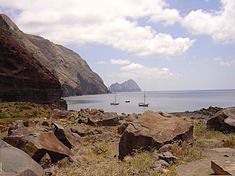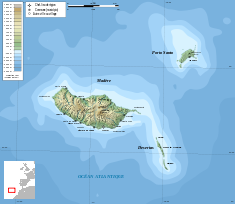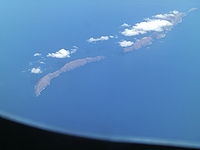- Desertas Islands
-
Desertas Island (Ilha) Visiting sailboats at the bay of the Nature Reserve; the islands are uninhabited, except for rangers that monitor activity on the islandsOfficial name: Ilhas Desertas Name origin: desertas, Portuguese plural of deserted Country  Portugal
PortugalAutonomous Region  Madeira
MadeiraLocation Tore-Madeira Ridge, African Tectonic Plate, Atlantic Ocean Archipelago Madeira Islands/Islets Chão Islet Highest point Boqueiro Norte - location Deserta Grande, Santa Cruz, Santa Cruz da Madeira - elevation 442 m (1,450 ft) - coordinates 32°32′46″N 16°31′31″W / 32.54611°N 16.52528°W Lowest point Sea level - location Atlantic Ocean - elevation 0 m (0 ft) Length 22.34 km (14 mi), Northwest-Southeast Width 1.34 km (1 mi), North-South Area 14.21 km2 (5 sq mi) Biomes Temperate, Mediterranean Geology Alkali basalt, Tephra, Trachyte, Trachybasalt Orogeny Volcanism Period Holocene, Pliocene Wikimedia Commons: Desertas Statistics from INE (2001); geographic detail from Instituto Geográfico Português (2010) The Desertas Islands (Portuguese: Ilhas Desertas, IPA: [ˈiʎɐʒ ðɨˈzɛɾtɐʃ], "Desert Islands") are a small Portuguese archipelago, located about 25 km to the southeast of Ponta de São Lourenço, the eastern tip of the island of Madeira, the whole chain located roughly between Madeira and the Canary Islands.
Geography
It is a chain of three long and narrow islands that stretch over a distance of 23 km north-south. Administratively, the islands are part of the municipality of Santa Cruz, Madeira, and therein of the civil parish of the same name. The islands are a designated nature reserve and a licence is needed to land there. Though close to the main island of Madeira, where the islands can often be seen on the horizon, the geology of the Ilhas Desertas is starkly different. The high, long, and rocky islands of the group are barren of soil, and the only wildlife consists of about sixteen species of birds, including eight species of seabirds, and a scarce population of feral goats, rabbits, and rodents, brought from Portugal by the mariners who first touched the rocky shores. Native species of tarantula, as well as reptiles, also exist in the fragile and arid ecosystem.
The only inhabitable island, with its own water source, is Deserta Grande. This water is however murky and scarce, and all historical attempts to colonise the island failed due to the impracticability of communal agriculture.
A tiny colony of Mediterranean Monk Seals inhabit the beaches, and since 1990 the islands have been a nature reserve for their protection. Although in 1998 the colony numbered only eight, by today, the population numbers roughly twenty. The only human presence are the permanent wardens, geologists, occasional boaters, and the few research stations on the islands.
The islands of the Desertas are, listed from north to south, with approximate area figures:
Island Area (km²) Height (m) Chão Islet 1 98 Deserta Grande 10 442 Bugio 3 348 TOTAL 14.21 442 See also
External links
Categories:- Uninhabited islands of Portugal
- Islands of the Autonomous Region of Madeira
- Islands of Macaronesia
Wikimedia Foundation. 2010.




